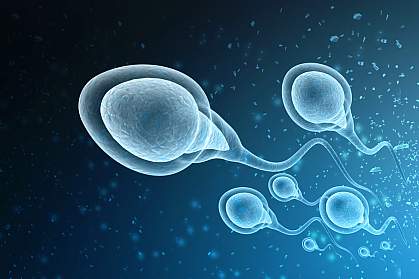You are here
June 11, 2024
Drug causes reversible male contraception in mice
At a Glance
- Scientists created a compound that causes reversible contraception in male mice.
- The findings suggest a potential path to developing a non-hormonal, reversible male contraceptive drug for humans.

In the 60 years since the introduction of hormonal birth control pills, the world’s population has more than doubled. Despite the availability of contraceptive methods, a large share of pregnancies worldwide is unintended. One of the challenges for family planning is that most contraception methods are for women. No oral contraceptive medications exist for men. Options for men are limited to withdrawal, condoms, and vasectomy.
Previous research found that mutations in a particular gene, STK33, cause abnormal sperm development and infertility in both men and male mice. The mutations don’t appear to cause any other health effects. This suggests that the enzyme encoded by this gene, serine/threonine kinase 33 (STK33), could be a target for male contraception. To this end, a team of researchers led by Dr. Martin Matzuk at Baylor College of Medicine sought to develop a drug that could inhibit STK33. The results of their study, which was funded in part by NIH, appeared in Science on May 23, 2024.
The team screened billions of compounds and found two that bound and inhibited STK33 potently and selectively. But both were quickly broken down by the liver. By modifying one of the compounds, the researchers created a selective STK33 inhibitor named CDD-2807. Compared to the original compound, CDD-2807 was more potent and lasted longer in the body.
The researchers tested the contraceptive effect of CDD-2807 in mice. Male mice treated with CDD-2807 or untreated controls were housed with female mice for up to six weeks. Compared with the control mice, mice treated with CDD-2807 sired few litters, with fewer pups per litter. The treated males sired no litters after the first month. Three weeks after stopping treatment, the treated mice sired offspring at the same rate as control mice.
Treatment with CDD-2807 had no clear effect on the overall health or mortality of the mice. The drug easily crossed from the blood into the testes but didn’t accumulate in the brain. Treatment also didn’t affect the size of the testes. Sperm from the treated mice had poor motility and function. The treated mice’s sperm also had abnormalities like those induced by STK33 gene mutations.
“STK33 is therefore considered a viable target with minimal safety concerns for contraception in men,” Matzuk says. “In the next few years, our goal is to further evaluate this STK33 inhibitor and compounds similar to CDD-2807 in primates to determine their effectiveness as reversible male contraceptives.”
To guide future modifications, the team also determined the structure of STK33 bound to an inhibitor. The structure revealed how the inhibitor interacts with the enzyme. It also suggested how chemical modifications might enhance these interactions.
STK33 belongs to a class of enzymes called kinases. Most kinase-inhibiting drugs have been developed for treating cancer. This study’s results suggest that kinases could be targets for treating a broader range of conditions.
—by Brian Doctrow, Ph.D.
Related Links
- Male Contraceptive Disables Sperm
- Experimental Male Contraceptive Blocks Sperm Movement
- How Sperm Are Activated
- Contraception and Birth Control
- Infertility and Fertility
- How Effective Is Male Contraception?
References: Reversible male contraception by targeted inhibition of serine/threonine kinase 33. Ku AF, Sharma KL, Ta HM, Sutton CM, Bohren KM, Wang Y, Chamakuri S, Chen R, Hakenjos JM, Jimmidi R, Kent K, Li F, Li JY, Ma L, Madasu C, Palaniappan M, Palmer SS, Qin X, Robers MB, Sankaran B, Tan Z, Vasquez YM, Wang J, Wilkinson J, Yu Z, Ye Q, Young DW, Teng M, Kim C, Matzuk MM. Science. 2024 May 24;384(6698):885-890. doi: 10.1126/science.adl2688. Epub 2024 May 23. PMID: 38781365.
Funding: NIH’s Eunice Kennedy Shriver National Institute of Child Health and Human Development (NICHD), National Cancer Institute (NCI), and National Institute of General Medical Sciences (NIGMS); Bill & Melinda Gates Foundation; A.I. & Manet Schepps Discovery Foundation; Cancer Prevention Research Institute of Texas; United States Department of Energy.
